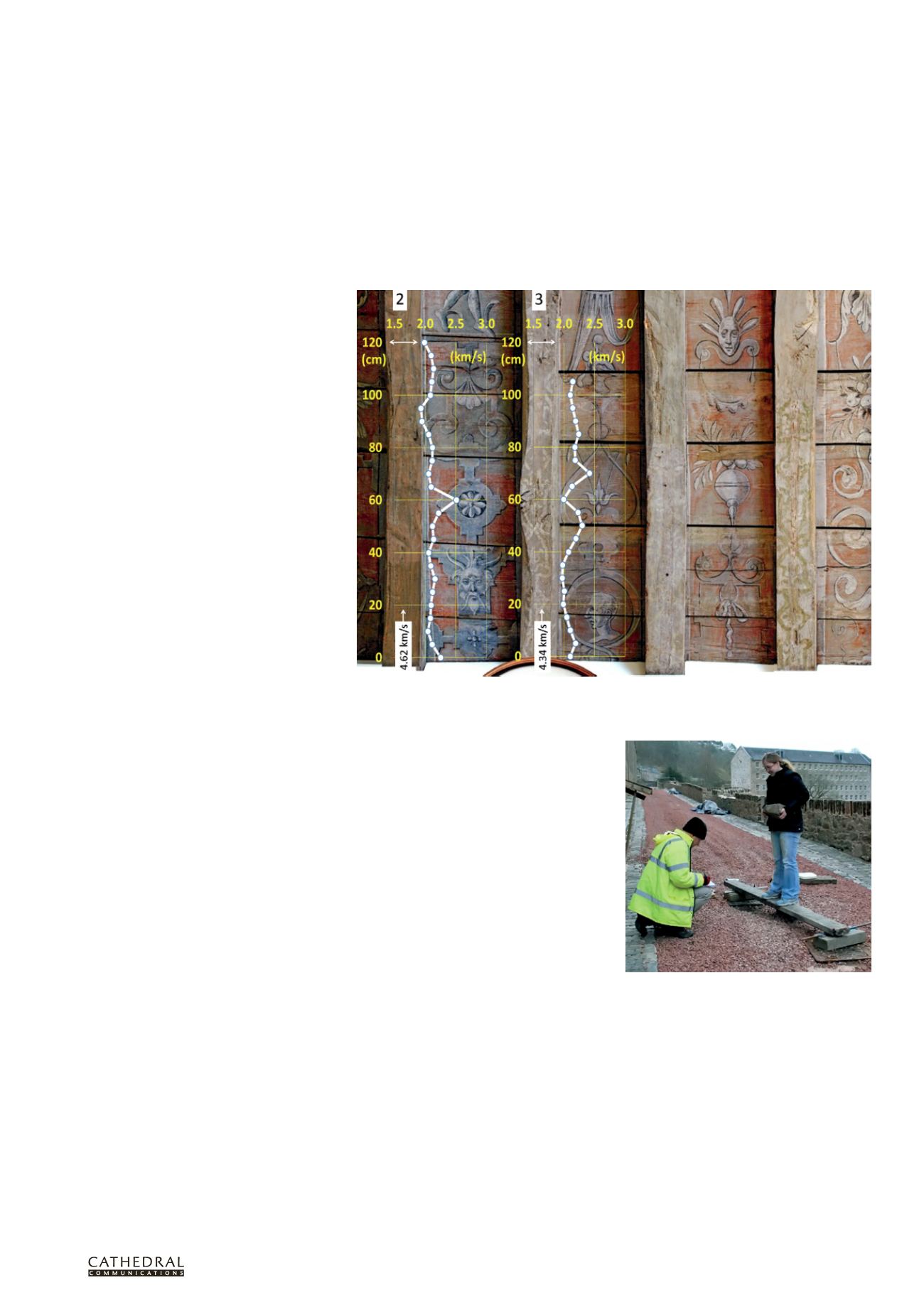
T W E N T Y F I R S T E D I T I O N
T H E B U I L D I N G C O N S E R VAT I O N D I R E C T O R Y 2 0 1 4
1 0 7
3.3
STRUCTURE & FABRIC :
ME TAL,
WOOD & GLASS
TIMBER FOR REPAIRS
PETER WILSON
T
HE SCIENCE
involved in the
conservation and repair of timbers in
existing buildings and structures has
made many advances in recent years, with
far more attention being addressed towards
understanding the mechanisms involved
in the aging of wood. It has long been
recognised that the strength and stiffness of
timber change over time, as do the moisture
absorption characteristics. However, the
desire to better understand why these
changes occur and what their implications
are has drawn archaeologists, architectural
historians, conservation architects, timber
engineers and wood scientists around Europe
towards an examination of some less obvious
but related areas of research.
More attention is now being given,
for example, to other areas of cultural
heritage, such as musical instruments,
in order to finds clues to the processes
involved in wood degradation. Identifying
the various species used in the manufacture
of traditional stringed instruments is only
the first task: the provenance and age of the
trees involved are also critical factors when
assessing the age of an instrument and the
acoustic qualities it derives from the almost
alchemical combination of wood, traditional
glues, design and form. Developing a better
understanding of the first two of these has
been fundamental to the modern techniques
used in instrument restoration, and this
knowledge has led historic building repair
specialists towards a deeper examination
of the historic forest resource and the
changes that have taken place over time
in the physical and mechanical properties
of the material derived from older trees.
An EU science and technology network
called COST (see further information) is
bringing together specialists in all areas
of forest and timber research, with the
assessment, reinforcing and monitoring of
timber structures having its own distinct
grouping and regular meetings at which
research findings can be shared, discussed
and subsequently disseminated to the
wider timber buildings conservation sector.
This sharing of knowledge and experience
is critical to current thinking about the
conservation of existing fabric and the
reversibility issues involved, specifically the
need to ensure that any repair made today
based on current scientific understanding
and technological capability will not further
damage the historic structure or inhibit any
future intervention necessary to preserve
the original fabric of the building.
IDENTIFICATION AND ASSESSMENT
OF HISTORIC TIMBER
Increasing attention is being given to non-
invasive assessment of structural timber
in historic buildings which avoids the
removal of existing material as samples for
the strength and stiffness testing necessary
to identify suitable replacement timbers.
Research at Edinburgh Napier University’s
Forest Products Research Institute (see
further information) on how to measure the
strength and stiffness of historic timbers in
situ has applied the experience gained from
other work in the forest environment to the
world of historic building conservation.
Rather than applying traditional, semi-
destructive testing methods, hand-held
acoustic tools are now being used to measure
the changes in physical and mechanical
properties involved when older timbers are
placed under new stresses, whether from
material degradation or from changes in
use that can adversely affect the loadings
on traditional timber structural elements.
Acoustic tools use measurable sound
transmission within timber. The sound wave
generated by a simple knock on the timber
will travel the length of the sample (a floor
joist or roof timber for example) and the time
this takes permits the material’s strength and
stiffness to be calculated. This very simplistic
description of the process involved perhaps
underplays the potential of this technique to
aid timber conservation and repair. This type
of testing not only obviates the time, cost
and possible damage involved in traditional
sampling and testing, but also provides
immediate results that allow the specialist
to make informed decisions as to the best
replacement material to use and the repair
method required.
Sound waves give a measure of timber strength and stiffness. Shown here are the results from non-invasive
acoustic testing of historic ceiling timbers in the traditional Scottish tower house home of John Napier (the
inventor of logarithms), which sits at the heart of Edinburgh Napier University’s Merchiston Campus.
A simple but effective approach to strength testing:
the timber shown here is from 18th-century
properties at New Lanark.


